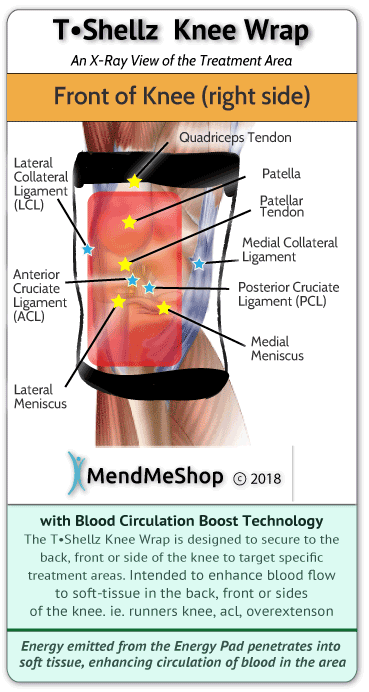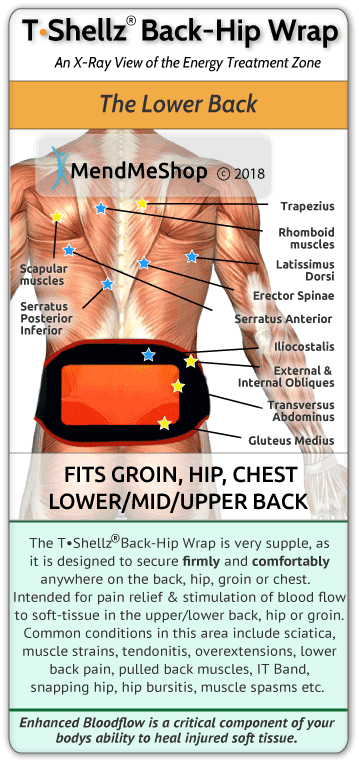Bursectomy - Surgical Bursa Removal Post-Operative Rehabilitation
If you are unsure about whether you need surgery, you may want to read through our "Do I Need Bursitis Surgery?"" Page.
If you want to know about the types of muscle surgery, you may want to read through our "Common Surgical Procedures for Bursitis" Page.
Immobilization & Rest for the Best Recovery
In almost all cases, postoperative care should include rest and restriction of movement for the affected area of the body. Depending on where the surgery occurred, 'rest' for the tissue can be made easier by immobilizing the joint in a cast or through use of a splint after surgery. For some injuries, soft tissue may need to remain immobilized for up to 6 weeks. Long-term immobilization in some cases will help the soft tissue that is forming be strong and healthy.
After Bursa Surgery is Done
During the first 24 to 72 hours after surgery, the area will be tender, swollen and quite painful. The pain will typically be minimized through pain meds (oral or intravenous) for a short term duration. You may be weak and unstable for a while. You may also have been outfitted for a cast, crutches, brace or some other form of support aid to wear for a period of time. You will be forced to take it slow - how long will depend on many factors.
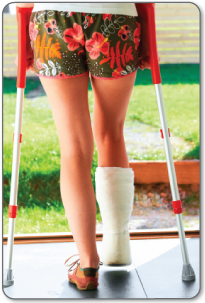
Right after surgery is when muscle loss easily gets very significant as it does not take long for unused muscle to disappear. This is a major reason why PT is absolutely necessary - you need it to rebuild muscle strength and increase your range of motion (which is typically severely restricted due to the surgery).
Muscle atrophy can begin after only a few days of disuse, and the extent of atrophy depends on the duration of disuse.
It only takes a few days for atrophy to begin. As time passes the muscle fibers shrink and the muscle loses strength and microscopic bits of tissue begin to die inside the muscle.
It is important to understand that surgery may not bring back 100% functionality of your injured foot, but you should be able to return to most if not all of your pre-injury activities. These surgical procedures are often performed with very successful results. What truly makes a difference is your commitment to a doctor recommended rehabilitation program after surgery as there is always a possibility of re-injuring your muscle even after a surgical procedure.
Ask any doctor and they'll tell you that the success of your surgery depends on your level of dedication to regular, at-home care of the area during your recovery. Nearly all of our bursitis post-op clients have achieved a successful recovery through regular use of a Cold Compress or Ice Pack and the TShellz Wrap® at home, in combination with their PT sessions.
The incorporation of conservative treatments at home (as instructed by your physician or PT) will lessen the chance and/or severity of joint degeneration and atrophy during your rehabilitation process.
Getting Started with Your Post-Operative Rehabilitation
If you've had surgery on your bursitis injury then your doctor will quickly get you on the path to rehabilitation. The aggressiveness of your rehabilitation efforts and your injury's ability to heal will depend on a variety of factors including (but not limited to):

- your age, overall health, and activity level
- the state of your bursitis injury before surgery (severe injuries like thickened bursa sac, tendon or ligament damage, an open wound, bone damage or fracture will require more intense surgery)
- the type of surgery you had
- how soon you need to return to normal activity
No two rehabilitation plans are alike - but know that the less invasive your surgery is, the quicker your road to recovery will be.
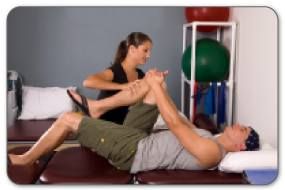
Proper post-surgery rehabilitation is very important, perhaps even more important than the surgery itself. Most patients can leave the hospital or clinic (as is often the case with arthroscopic surgeries) the same day using crutches, a cane or perhaps just a splint. You will be required to follow up with your surgeon and a physical therapist and they will advise you on your recovery.
The goal of a rehabilitation plan is to manage pain and swelling while improving function, strength, and range of motion. Ultimately, the goal is to regain strength and return to full activity. You will most likely spend a lot of time with a physical therapist after your surgery, but as your healing progresses, emphasis will be placed on your personal at-home treatment. The success of your rehabilitation will depend on your dedication to working with your doctor and physical therapist while also managing your recovery on a daily basis at home.
Regardless of what type of surgery you've had (or even if you don't need surgery) your home recovery routine can be improved by controlling initial and on-going pain/swelling, and increasing blood flow to accelerate the body's ability to heal your fascia, muscles, tendons, and ligaments so that you can achieve long-term, positive results. This can be more easily done by incorporating a Cold Compress or Ice Pack and a TShellz Wrap® into your rehabilitation routine. Regular treatment with a TShellz Wrap is intended to provide an increased localized bloodflow while elongating and increasing flexibility of tissue in the treatment area (temporarily - during treatment and shortly thereafter). Not only does the boosted blood flow increase your body's natural healing rate, the increased tissue length and flexibility reduce your risk of further injury. Re-injury and strains that occur during your recovery will setback your healing rate substantially - this is key... if you want to heal fast, increase bloodflow in the area, and do not suffer further injury - and this is the advantage that a TShellz Wrap® can give you. An enhanced healing rate decreases your time spent in recovery, minimizes the growth of scar tissue (due to lower reinjury) and helps prevent a worsening injury over time.
Post-Operative Rehab Phase 1:
Protect your Surgery Site & Start Moving
Each injury/condition will have different challenges for you after surgery. Your surgeon and/or doctor will provide you with clear direction on how to protect your wound and deal with pain so you can achieve a tolerable level of comfort during your recovery.
The level of protection needed will depend on the type of surgery you have had. Generally, for arthroscopic and open release surgeries, you may need to wear a sling(shoulder,elbow), brace or cast (knee, ankle, foot, wrist) for at least a week after surgery, or until your first follow-up appointment with the surgeon. You may be advised by your physician not to drive or operate a motorized vehicle for at least a week after your surgery. This is because restriction of movement may directly affect your ability to steer your vehicle, particularly in an emergency situation which may require rapid, deliberate movements.
Rehabilitation after surgery will first focus on protecting the area and initiating simple movement. Start doing simple movements to gain motion, preventing scar tissue formation which might limit your range of motion and cause further damage to soft tissue.
Directly after your surgery has been completed, you will go through Step 1 of the healing process by stopping the bleeding that has started because of the incisions and work done inside your body. Depending on the type of procedure you have just had, your soft tissue may be sutured together, reconstructed or removed to fix your underlying condition. In any case, as with any injury to soft tissue, there will be some bleeding. Depending on the type of injury you have, your surgeon may even stimulate bleeding during your surgery to trigger the healing process.
Typically, your body will have begun to stop the bleeding as soon as your surgeon has completed the surgery. This means that the veins carrying your blood will close off, and your blood will coagulate (condense to seal the bleeding off) in order to reduce the amount of blood loss in your body. Your body knows to do this automatically because blood is so vital to the healing process. Blood is basically the vehicle for oxygen and nutrients that travel directly to damaged cells - where these things are needed most.
In order to reduce pain, swelling and inflammation your doctor will prescribe an anti-inflammatory drug to be taken during the first 4 weeks after your surgery, or for however long it is needed, depending on your pain level. Your surgeon will also recommend the use of a Cold Compress or Ice Pack on a frequent basis - multiple times per day - to control your inflammation and reduce your pain.
If your surgery was arthroscopic in nature, you should have relatively little bleeding/blood loss. Your doctor or surgeon will check before you leave to make sure bleeding at the incisions has stopped. If you have undergone an open surgery, your doctor and/or surgeon will check your incisions periodically over the next few days of your hospital-stay to ensure that your body has stopped the bleeding on its own and also make sure that your incisions are starting to heal.
Movements to Watch Out For After Surgery
Depending on the joint that was operated on, you me be advised by your physician NOT to drive or operate a motorized vehicle for at least a week after your surgery. This is because you will have still have limited range of motion. However, for elbow or shoulder surgery, you are probably finding it difficult - if not impossible - to drive anyway... so this shouldn't surprise you.
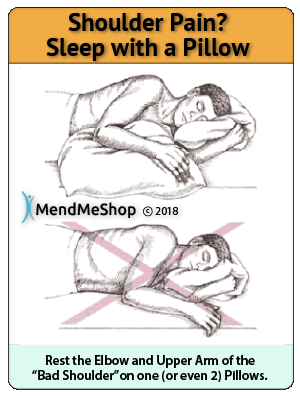
Right after surgery, avoid straining the joint that was just operated on. Do not lift heavy objects and try not put any strain on the joint for four to six weeks following surgery - this may include using a keyboard / mouse, mobile phone, climbing stairs, and even dressing.
Sleeping may provide a challenge for quite a few people. For elbow or shoulder surgery, try putting a towel roll under your elbow to support your arm. Adding an incline wedge to your bed may be more comfortable than lying flat.
For sleeping after knee surgery, it is recommended to: [1]
- Sleep on your back (not your stomach)
- When sleeping on memory foam, use a pillow or foam wedge under your knee
- Don't sleep on your stomach
- If you sleep on your side, sleep on the side that was not operated on with a pillow or two between your legs to keep your recovering knee stable
- A recliner or zero gravity chair will provide good knee support & promote good blood circulation while keeping your knee stable.
For sleeping after hip surgery, it is recommended to: [2]
- Sleep on a firm bed or mattress.
- Use a pillow between your knees
- Don't sleep on your stomach
- Don't sleep with pillows beneath your knees
Your surgeon may instruct you to wear a sling/cast/brace/walker at all times for 4 to 6 weeks. The length of time needed will depend on the type of surgery you have had. You may remove the sling/brace/cast for exercise as prescribed by the surgeon or therapist, icing, dressing and showering. Normal daily activities around the house and/or work activity may be considered acceptable as long as you wear the sling/brace/cast.
After your incisions & repaired and/or removed tissue has stopped bleeding; the area will most likely be tender, swollen, red and hot to the touch - these are all symptoms of inflammation. Step 2 of the healing process is inflammation reduction. At this point you will be home if you have had arthroscopic surgery, or you may still be in the hospital if you have had open surgery. In order to reduce pain, swelling and inflammation, your doctor will prescribe an anti-inflammatory drug to be taken during the first week or 2 after your surgery. Your surgeon will probably recommend use of a Cold Compress or Ice Pack at this stage for 15 to 20 minutes at a time, several times a day, to control inflammation and reduce pain.
Rest at this point is vital to your rehabilitation plan depending on the surgery you have undergone. If you have had arthroscopic surgery with minimal internal wounding from your surgeon, you may be encouraged to start movement early or as soon as possible. Limited movements of the area will be required in most cases after the surgery. If you have had an invasive open surgery, then you may be encouraged to rest longer at first before starting movement. Depending on the type of surgery you have undergone, rehabilitation with a physical therapist will begin 2-6 weeks after surgery.
Your doctor or surgeon will advance you to the next phase of rehabilitation when there is no evidence of inflammation or swelling in the area. If you have had arthroscopic surgery, your doctor may expect that you are able to move the area around pain free before moving onto the next Phase of rehabilitation.
Post-Operative Rehab Phase 2:
Gain Back Range of Motion (ROM) & Increased Stability
After soft tissue starts to heal your muscle(s) will be in a weakened state and will not be as strong as they were previously for some time. This is why you need to be on "re-injury watch" and make the most of your PT appointments and home therapies during your rehabilitation. It would be devastating to "overdo it" at any point during the first few months of rehabilitation as this would most likely send you right back into the operating room.
After the initial phase of your post surgery recovery (when Step 1 and 2 of the healing process is complete), temporary tissue will start to grow around soft tissue that was damaged during your injury or the surgery. Step 3 is the Growth of Temporary Tissue.
Typically - though not always, approximately 2-6 weeks after surgery your surgeon will recommend regular physical therapist (PT) appointments where you will be encouraged to (1) gain back range of motion (ROM), and (2) increase the stability of the recently repaired area. Your PT appointments will be 1-3 times per week, and progression of movement in the recovering joint will be the guide. You will start with gradual, controlled movements in a free (non-forced) way with little weight or resistance - normally with very few repetitions of activity. Strengthening exercises will slowly increase in difficulty (with more resistance) after your surgery. You will be stiff and in pain at first; simple, easy movements may seem challenging in the beginning - but don't get discouraged, your hard work will pay off in the end.
You might start with gentle active limb extensions and flexion exercises with a hard brace/cast on at 0 - 14 days. In weeks 2 & 3, when you're out of a hard brace, pain is the guiding factor with tolerance of weight-bearing for any exercises.
Strengthening exercises will slowly increase in difficulty (with more resistance) around 3 - 8 weeks after your surgery.
At about 6 to 12 weeks (depending on your type of surgery) you still need to allow for healing from the surgery. Although you may be feeling much better and your pain is reducing, repaired soft tissue at 4 weeks is typically only 20% healed. At 8 weeks it will be about 40% strong and after 12 weeks a tendon is approx. 60% as strong as a normal tendon. The point where the pain decreases yet the tendons and muscles are still weak is a VERY critical point. This is the stage where you need to be very careful about re-injury.
At Home Stretching/Exercise - Your therapist will encourage you and tell you just how important it is to commit to regular exercise at home as well as in the clinic. You should be doing home exercises up to 3 times per day. They will give you exercises and guidance based on your overall soreness level and your morning discomfort.
We typically advise our clients to apply a TShellz Wrap® treatment to help loosen up before stretching (or exercise). Apply a TShellz Wrap treatment for approximately 15 to 20 minutes (finishing 15 minutes before exercise) to help increase elasticity and flexibility of your tendons, ligaments and muscles. The increased elasticity will help minimize tissue tears and scar tissue growth that may be incurred during stretching. Overall, we advise TShellz Wrap® treatments before exercise (or work) to help increase ROM and decrease re-injury risk.
Controlling post-exercise swelling and inflammation is crucial during this Phase. Any sign of swelling or inflammation after exercise may be an indication of minor re-injury to soft tissue in the joint. Control your inflammation immediately after exercise with a 15 to 20 minute cold treatment. If you are not careful to treat your swelling or inflammation immediately after exercise you may experience a set-back in your recovery.
Your doctor, surgeon or physical therapist will advance you to the next Phase of rehabilitation when you show measured improvement of range of motion (ROM), strength, stability and flexibility in the affected joint. The level of improvement will depend on the severity of your injury and the type of surgery you have had. For example, if you have had a relatively simple arthroscopic repair of tissue, you may be expected to move your joint around to show your muscles/tendons are functioning well before moving to Phase 3 of your rehabilitation.
Post-OP Phase 3:
Gain Back Full Capability
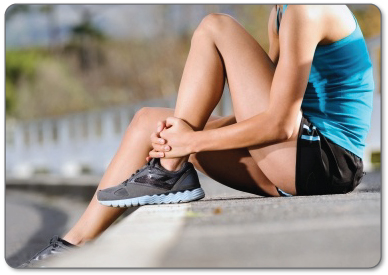
After temporary tissue has grown (Step 3 of the healing process), this temporary tissue will go through different stages of conversion into healthy, normal, flexible tissue. This is Step 4 of the healing process (Complete Tissue Re-Growth). Before converting into healthy tissue, temporary tissue will often become tough, dense, fibrous scar tissue. Scar tissue has an unorganized, inflexible tissue structure, which makes it brittle. Scar tissue will provide your injury with more long term fusing power, but will also stick to surrounding healthy tissue and even bone. The growth of this scar tissue is what stiffens the joint, restricting movement and flexibility.
This Phase of your rehabilitation will focus on an increase in activity level in order to regain full range of motion (ROM) and muscle strength in the area. Continued exercise and activity will break up and soften scar tissue. Your doctor or PT will increase your activity by introducing the regular use of equipment to strengthen the joint - perhaps a rowing machine, weight press or pull-down machines, depending on the area they want to strengthen.
Use a TShellz Wrap® BEFORE exercise/stretching and use a Cold Compress or Ice Pack after exercise. This protocol will go a long way to maintaining overall tissue stretch-ability, reduce re-injury risk, and treat any pain, swelling or inflammation due to overexertion of your muscle(s). If you are noticing any recurring inflammation, continue cold treatments as recommended by your doctor.
Your doctor or physical therapist will advance you to the next Phase of rehabilitation when you have regained full ROM (range of motion) without pain. You may also have to pass clinical exams or tests of your muscle strength, balance, stability and flexibility in order to be cleared for Phase 4.
Post-OP Phase 4:
Return to Regular Use & Activity
Depending on your job (and whether your occupation has contributed to causing your condition), you may be able to return back to work from within 6 to 12 weeks after the surgery. Overall healing of the joint after surgery may take upwards of 6 to 12 months, which means you may not be able to return to sports or do heavy, forceful activities until a year has passed after your surgery.
When your overall condition and range of motion has improved to a satisfactory level, your doctor or physical therapist will clear you for a return to work or athletic activity. In many cases, they may recommend that you continue muscle strengthening and stretching instructed during your rehabilitation in order to maintain healthy ROM of the affected joint. Additional cardiovascular exercise will also be encouraged. If you are an athlete or have a job that requires extensive physical capability, your doctor or physical therapist will likely advise a very gradual return to previous activity.
Scar tissue may plague you for weeks, months and maybe even years after your surgery depending on your level of activity and the amount of conservative treatment you have undergone during your rehabilitation. Scar tissue will be a major problem as scar tissue can easily build up quickly and its hard to get rid of.
Even if you have been cleared to get back to activity, you still must be careful with the activity you take on. You need to keep in mind that your joint won't be back to 100% for some time (recovery rarely reaches 100%) and so continued stretching with exercises and stretches, treatment with the TShellz Wrap® and a Cold Compress or Ice Pack during flareups of swelling will maintain good health of the post surgery area and significantly reduce your risk of re-injury.
A Post-Operative Recovery Summary:
Your success to recovering from surgery is up to you. Many of our past clients have found the following points to be quite valuable during their recovery period.
- listen well to your physician, and remember to stick to your conservative treatment plan. Using these therapies every single day will help maximize the opportunity to heal and minimize the amount of scar tissue that will grow in the wound.
- know that frequent use of a Cold Compress or Ice Pack will help reduce the swelling very quickly. Much of the pain you feel will typically be from the swelling, and you'll be surprised how fast pain drops once the swelling is down. Scar tissue growth is further inhibited by a reduction in inflammation (swelling restricts blood flow - tissues die without blood and scar tissue grows in its place)
- Consistent use of the TShellz Wrap (a safe, carbon fiber mesh, fda registered medical device) is intended to help reduce scar tissue growth, increase flexibility in tissue and increase blood flow to the treatment area (thereby accelerating the body's own healing process). (Do not use if there is a lot of swelling or the incision site has not healed yet and only once you assigned stretches for home - generally at least 6 weeks after)
- use the TShellz Wrap before physical activity or stretching. Heat emitted from the TShellz Wrap will help connective tissue in the application area elongate, and stay elongated for some time after treatment. It will also temporarily increase the flexibility of soft tissue, meaning that it helps improve range of motion while simultaneously reducing your risk of re-injury which is exactly what you want when trying to recover from tendon and muscle damage.
- stretching, as assigned by your PT or doctor can not only help get rid of scar tissue, but also promote growth of healthy, flexible tissue.
Overall, continued treatment with the TShellz Wraps® and a Cold Compress or Ice Pack will maintain good health in your joint and significantly reduce your risk of re-injury.
We believe the use of TShellz Wraps® for boosting blood flow to in the area of application is one of the most under-utilized home treatment options available on the market today. We have client after client that have tried many options out there and have been amazed at how effective and fast the TShellz Wrap treatment can relieve pain and increase blood flow in the treatment area.
The intent of TShellz Wraps are to significantly increase bloodflow to tissue in the treatment area - period. With regular use of the TShellz Wrap:
- Your pain will be reduced.
- With increased blood flow, soft tissue in the area will most likely recover at an accelerated rate*.
- Due to increased warmth, soft tissue in the treatment area will have an enhanced range of motion and increased extensibility*. This should translate into a reduced rate of injury occurrance as soft tissue becomes more flexible.
(*Chapter 9 of "Therapeutic Heat and Cold", 4th edition. Ed. Justus F. Lehmann, M.D., Williams, and Wilkin)
Attach the TShellz Wrap®, plug it in and let the Energy Pad do the work!
*Know that every personal soft tissue injury is unique and the TShellz Wrap may not work for everyone. This is why we offer a 60-day money back return on all our TShellz Wrap devices. Our high quality wraps are registered with the FDA as medical devices which meet high manufacturing standards.
Expectations for Long-term Recovery
Rehabilitation after your surgery is just the beginning of your recovery process. Even after you've had surgery to fix your injury and deal with the build-up of scar tissue, it is improbable that your soft tissue will heal 100%. From this point forward, it is more important than ever to be careful with your recovered injury. It is almost a certainty that the area will be weaker now, and your risk of re-injury is just that much higher because of this.
Manage Your Symptoms On A Daily Basis To Prevent Re-Injury
It is generally a straightforward process to manage long-term healing of your soft tissue injury with conservative treatment methods that can be conveniently used in the comfort of your own home. If you are looking for all-natural forms of pain management and a Localized Enhanced Circulatory Response mechanism for long-lasting relief, seriously consider the benefits of incorporating the TShellz Wrap into your treatment plan.
The application of a Cold Compress or Ice Pack can help decrease post-operative pain and swelling while also managing pain from occasional inflammatory flare-ups (re-injury).
During your last few stages of rehabilitation, while you are undergoing PT and focusing on improvements to your range of motion, it is important to maintain healthy blood flow in the area. Strong and healthy bursae, tendons and muscles need a solid blood circulatory system and this is exactly what our TShellz® Circulatory Boost Wraps are made for.
Reduced blood flow slows down your recovery process. If your soft tissue is always starved for more blood flow, it will be at a higher risk of re-injury which will undoubtedly set back your healing progress.
Use a TShellz Wrap® regularly to prevent re-injury and keep your muscles, tendons and ligaments elastic and flexible. Healthy blood flow is vital to the healing process after surgery. Your blood flow is what brings oxygen, nutrients and energy (things needed to heal) into your damaged tissue. Blood flow promotes tissue re-growth, strengthening the delicate work your surgeon has done.
Regular treatments with the TShellz Soft Tissue Wrap is intended to increase localized blood flow for up to 4 hours with just one 20 minute application! There simply isn't a better home product on the market to enhance your body's natural healing process and provide long-term health benefits.
Scar Tissue - We Need It For Kick-Starting Tissue Repair, But After That It's Nasty Stuff
Even when you're injured and in pain you need to keep moving to break up scar tissue that's forming around your bursa. Moving when you're injured is hard. Since moving while injured can be painful - most people think it's better to stop moving, rest their body and hope that their bursitis will heal all on its' own - even after surgery. Even though rest is important to recovery too much rest during the recovery process will increase the amount of scar tissue in your joint.

Bursae, tendons, ligaments, muscle and other forms of connective tissue are all meant to be soft and flexible, ready to work and move extreme forces in everyday activities. When I say force, I mean try to imagine the amount of force that some of your bursae handle on a daily basis. Try to image the amount of tension put on a bursa on the back of your heel when you stumble during a walk and put a load equal to 2 times your body weight on one of the balls of your foot. Imagine the amount of tension that is put on your ankles, hips and knees when running or climbing stairs - even when you are just walking even, let alone running. Shoulders and elbows often deal with heavy or repetitive forces at work if you are a tradesman, garden or work in an assembly line. Try to imagine the amount of force that your arm puts on your elbow and shoulder when you are just trying to throw a football or lift something heavy. This is why soft tissue injuries that occur in areas of high tension are difficult to completely fix - once connective tissue is weakened substantially and scar tissue begins to grow in the foot.
Scar tissue grows in damaged tissue when it tries to heal; little tiny band-aids that overlap each other to bind tiny tissue tears together. Scar tissue is dense, inflexible and brittle; with this added scar tissue, muscles, tendons & ligaments become rigid and unable to handle the forces that it once could. If scar tissue is found in a bursa, this can impede joint movement and/or cause pressure points - increasing the risk of further soft tissue injuries and inflammation. If you're suffering with scar tissue now you may feel the effects with stiffness, tightness and weakness in the area. Worst of all, you will feel sharp bursts of pain if you move the joint too much - this pain is from scar tissue tearing away from what it has attached to.
On-going issues with scar tissue can result in soft tissue tears and an increased chance of strain to nearby tendons, muscles and ligaments (as they are now handling higher forces due to overcompensation).
Scar tissue is one of the MAIN reasons why a chronic injury has not healed and your Range of Motion (ROM) is reduced from what it once was.
Scar tissue will form fast to deal with a soft tissue injury (such as bursitis, tendonitis or muscle strain), and this scar tissue will attach to EVERYTHING in the area, including the surrounding healthy tissue as well. This can result in a fusing together of soft tissue that shouldn't be fused together, and this will cause extreme pain when you move the area - it is literally ripping scar tissue. This is why PT is often painful - the therapist stretches the joint, forcing scar tissue bonds to break so you can regain your range of motion.
Scar tissue is a major problem - it is difficult to treat and can cause your injury to become chronic - taking months or even YEARS to completely heal!
Dealing with Scar Tissue After Surgery:
How Scar Tissue Affects Your Rehabilitation
Scar tissue will be present after any type of surgery, whether you've had surgery to remove your bursa or drain fluid from your joint. The human body will use scar tissue as a temporary solution and will try to build the scar tissue as fast as possible to heal the area. Scar tissue can form fast to bind everything together in your joint, but working fast doesn't mean that the job's done right. When scar tissue forms it doesn't come together as neatly as regular (healthy) soft tissue would. Scar tissue fibers will lay down over top of the damage in and around your bursa in a cluttered, messy and jumbled up way.
The growth of scar tissue is ultimately what causes stiffening in the joint, restricting movement and flexibility. Scar tissue is something that will be present in your soft tissue before and after your surgery - it can be minimized through use of minimally invasive surgeries (arthroscopic) but never completely avoided. As with nearly any surgery, the surgeon will weigh the costs versus the benefits of performing surgery on each particular case. Your surgeon will determine if the anticipated outcome from surgery will be successful, despite the build-up of scar tissue that you will develop as a result of the surgery. Overall, the surgeon may be able to remove a lot of the initial buildup of scar tissue around the injury and in doing so, achieve a positive outcome from the surgery.
Unfortunately, scar tissue may plague you for weeks, months and maybe even years after your surgery, depending on your level of activity and the amount of conservative treatments you have done during your rehabilitation. Scar tissue can become a major problem in a short amount of time.
Scar tissue is something that needs to be dealt with fast. If you try to get back into your regular daily activities after surgery with a mound of scar tissue in your joint you'll have a higher risk of re-injury and also overcompensation injuries. Scar tissue is just not built to withstand the pressures of regular activity.
If you have an injured bursa with a lot of scar tissue and re-injure that tissue, even more scar tissue will grow to fill in those tears. If you keep falling into the dangerous cycle of re-injuring your bursa without proper treatment you could end up with massive amounts of scar tissue in your joint. Your ability to move your affected joint in a normal way will be impaired as the amount of scar tissue increases.
The only solution to truly recover from invasive surgery for good is to break up scar tissue and avoid re-injury to minimize further growth of scar tissue.
Minimize scar tissue growth and reduce risk of re-injury or secondary injury by:
- (1) increasing blood flow to the area &
- (2) increasing elasticity of soft tissue in the area &
- (3) elongating soft tissue in the area.
You can accomplish all three of the above goals by incorporating a stretching plan and treating yourself consistently, every day with a TShellz Wrap.. In our opinion, treating yourself with a TShellz Wrap® is the easiest and most effective home treatment option to achieve both an increase in flexibility/elasticity while also triggering the body to maximize its potential to heal quickly due to the substantial increase in blood flow.

MendMeShop Arnica Infusion Pain Relief Gel
Pain Keeping You Awake?
Pain Keeping You In Bed?
Pain Got You On Edge?
Temporary Relief from Serious Pain For People Who Are Serious About It!

MendMeShop Sesamoid TShellz Wrap®
This wrap is designed to:
- increase extensibility & flexibility of metatarsals/sesamoid/toe areas during treatment & for a short while after
- increase blood flow in the application area
- be used on the TOP or BOTTOM of the foot
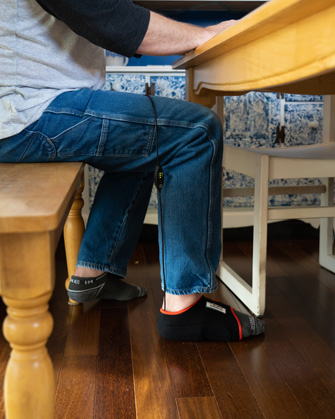
MendMeShop Plantar TShellz Wrap®
Augment your recovery while reducing risk of re-injury. A Plantar TShellz application is intended to:
- increase extensibility & flexibility of bottom foot fascia during treatment & for a short while after
- increase blood flow in the application area
When to use a Cold Compress or Ice Pack:
- 24 to 72 hours after your initial injury or when you first notice pain and swelling to stop further damage to tissue, relieve pain, and decrease swelling.
- After exercise, workouts or activity of any kind to prevent re-injury.
- Before and after surgery during rehabilitation to control pain and swelling for both pre-surgery and post-surgery.
- Anytime you feel that soft tissue (muscles in particular) has been over-extended, over-worked, twisted, strained or sprained causing pain and swelling.
- Anytime you have swelling, sharp throbbing pain or inflammation.
- Any other situation where you need to draw the pain and inflammation out of the area.
When to use a TShellz Wrap® for Bursitis:
- After swelling and inflammation are reduced.
- BEFORE getting out of bed in the morning. BEFORE going to bed at night.
- BEFORE exercise, workouts or activity of any kind to warm up the foot and increase length & elasticity of muscles, ligaments & tendons at the affected joint. Increased elasticity and length of soft tissue is intended to help reduce risk of of re-injury and secondary injuries (such as achilles tendonitis occuring due to retrocalcaneal bursitis).
- AFTER surgery (once the skin wound has healed over and your physician approves) to boost blood circulation, helping surgically repaired tissues rebuild for long-term health and minimize scar tissue growth at the surgery location.
- Anytime BEFORE you feel you might undertake activity that will put significant strain on your foot.
- Any other situation where you need to increase blood flow to soft tissue to relax the area, relieve pain / spasms, prevent re-injury and enhance flexibility of tissue in the treatment area.
Improve Circulation & Reduce Re-Injury Risk with the TShellz Wrap®
If you want to heal quickly, you need to keep your blood moving and that's where Circulatory Boost, comes in. What is Circulatory Boost? It's a substantial increase in the flow of blood to soft tissue without the need to exercise your already damaged tissue.
Have you seen what happens when you add water to a flower wilted from drought? In essence, your injured achilles or calf muscle is much like a "wilted" flower; your body wants to heal its injury, but needs lots of nutrients to do it. Blood brings new life to your tissue by delivering nutrients and oxygen that are vital for them to flourish. In addition, the blood carries away toxins and waste - cleaning the area so the body can continue with its healing process efficiently. Without a good supply of blood, your injury simply won't heal properly.
Using a TShellz Wrap® will not expose you to the risk of causing further harm to soft tissue like you can when using rigorous exercise. The TShellz Wrap® accomplishes the goal of enhanced blood flow without the need for intensive exercise and as such reduces your risk of re-injury.
Are You Dealing with Rehabilitation After Bursitis Surgery (Bursectomy)?
We Have Answers that can Help...
Most cases of chronic bursitis injuries will respond VERY well to conservative treatments, however, surgery will be needed in some cases (especially if your bursa needs to be removed). Undergoing bursitis surgery, whether you're having your bursa drained or removed, can be a scary and challenging time for most.
The Internet and any medical professionals available to you (your surgeon, orthopaedic specialist and/or PT) will provide a wealth of information and details on the surgery itself, but it can be a challenge to fully understand the medical terminology used, how your body reacts to the surgery and what comprehensive rehabilitation plan will get your body healed as soon as possible.
Surgery in itself is not the end of the journey, it is merely
the beginning of a new chapter. Your rehabilitation efforts will have an important impact on how soon you can return to living and enjoying your normal daily life.
It truly takes a cohesive rehab plan after surgery - incorporating conservative treatments, rest and PT/exercise - to ensure a complete recovery takes hold. There is no single answer and each individual experience in rehabilitation is different. We here at AidMyBursa provide suggestions and options for people to help get them through this life changing event. We assist many people in shaping an individual course of action to help through the recovery cycle.
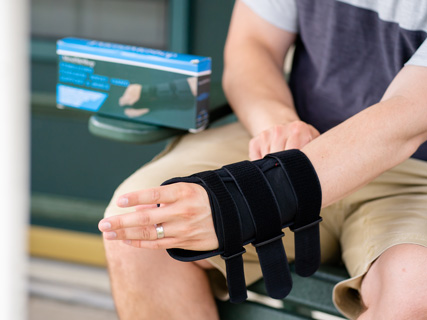
The MendMeShop Wrist Brace
This wrist brace contains a removable aluminum splint, providing the option for very firm support if desired. The use of this brace provides:
- excellent wrist support in a long lasting brace
- a 3 strap system to provide highly adjustable support
- all day comfort due to the breathe-able fabric and excellent cushioning
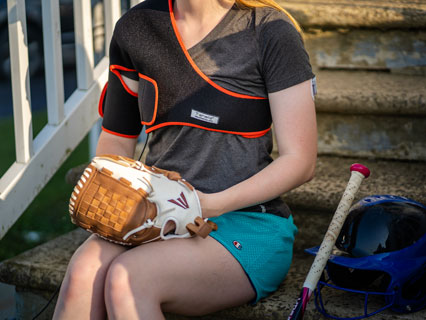
MendMeShop Shoulder TShellz Wrap®
Augment your recovery while reducing risk of re-injury. A TShellz application is intended to:
- increase extensibility & flexibility of shoulder soft tissue during treatment & for a short while after
- increase blood flow in the application area
- be used on either shoulder
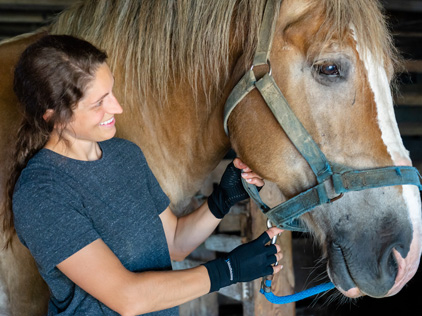
MendMeShop Compression Gloves
Help manage soreness and stiffness with these breatheable, fingerless gloves. The use of these gloves provides:
- light, balanced compression
- odor control with the copper infused fabric
- all day comfort due to the breathe-able fabric and the open fingers
The Next Step Is Up To You!
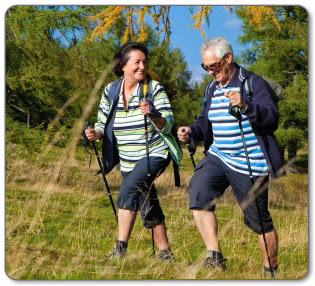
Living with pain is never easy as it affects your entire lifestyle. Living with pain during or after intensive surgery with a lengthy rehabilitation period can be even harder! Nothing is more important than making the proper decision when it comes to treating your bursitis and joint pain after surgery.
Doctors and Surgeons are always improving the technologies used in surgery, and results from surgery now are much more positive than they were in the past. However, all surgeries introduce scar tissue, and full recovery from surgery is often less successful than you might expect. If you do wind up getting surgery, know that rehabilitation at-home while attending regular PT or doctor appointments is vital for your overall recovery. It is especially vital to joints that consistently handle extreme forces. Consistent exercise and conservative treatment on a daily basis during your rehabilitation while working with your doctor, surgeon or PT is key.
AidMyBursa stands out in this regard as our goal is to help you recover 100% for the long term during your post-operative rehabilitation and beyond.
We strongly believe that we can help you, and we have thousands of happy clients to back this claim. You are welcome to try our products for a 60 day period.. If you are committed to following the treatments outlined in the product instructions we are very confident that our TShellz Wraps will aid you immensely. If you do not receive the benefits that countless of our other customers have experienced from our products, call us for instructions to mail the product back and we will provide you with a full product refund.
Our online shop accepts Visa & Mastercard as well as a Paypal Payment option.
We also encourage your to Call Our Office at 1-866-237-9608 (toll free continental NA) where we can answer any questions you have and/or take your order via phone.
The bottom line is, you are welcome to try our products for a full 2 months. If you do not receive the benefits that others have experienced, simply call us to return your purchase back to us and we will issue a prompt & full refund. There will be no hard feelings.
Product specialists are available 9:00 am to 5:00 pm Eastern Standard Time Monday to Friday.
If any question or concern arises, call us or simply send us an email at any time (we check our emails constantly all throughout the day and night.. even on holidays!). We will respond as soon as possible.
North America Toll Free 1-866-237-9608
Outside North America +1-705-532-1671
FREE SHIPPING ON ALL PRODUCTS CURRENTLY ENABLED
Please be aware that this information is neither intended nor implied to be a substitute for professional medical advice. All testimonials and comments reflect the real life experiences of individuals that used our products, however, individual results may vary. Always seek the advice of your physician or other qualified health provider before using any of our outstanding products to make sure they are right for you and your condition or if you have any questions regarding a medical condition.
For more information, call us via: 1-866-237-9608 or send us an email. View our Privacy Policy.
The terms Inferno Wrap®, Freezie Wrap®, T-Shellz® and Mendmeshop.com® are registered trademarks of In.Genu Design Group Inc.
All images shown are exclusive Copyright© 2006 - 2025 AidMyBursa.com.
Sources:
Ellis, N., Ellis, S., Ellis, Nicky et al. "The 3 Best Sleeping Positions After Knee Arthroscopy." We Sleep Well. N. p., 2018. Web. 19 Oct. 2018.
Sleeping After Hip Surgery | Cleveland Clinic." Cleveland Clinic. N. p., 2018. Web. 19 Oct. 2018.
